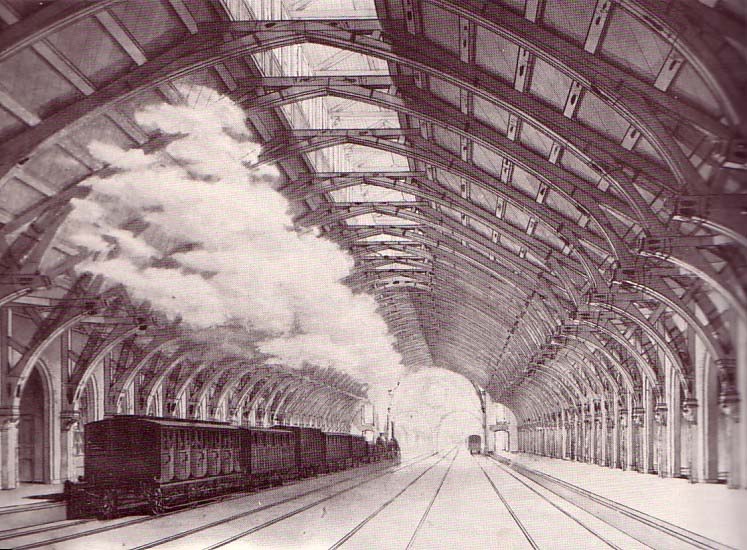Hamburg Berliner Bahnhof on:
[Wikipedia]
[Google]
[Amazon]



 The Berliner Bahnhof (Berlin line station) in the German city of
The Berliner Bahnhof (Berlin line station) in the German city of



 The Berliner Bahnhof (Berlin line station) in the German city of
The Berliner Bahnhof (Berlin line station) in the German city of Hamburg
Hamburg (, ; ), officially the Free and Hanseatic City of Hamburg,. is the List of cities in Germany by population, second-largest city in Germany after Berlin and List of cities in the European Union by population within city limits, 7th-lar ...
was the western terminus of the Berlin-Hamburg railway opened in 1846. It was previously the site of the station built in 1844 to a design by Alexis de Chateauneuf for the Hamburg-Bergedorf Railway. Berliner Bahnhof was completed in 1857 and closed in 1903.
Structural features
The former Bergedorfer Bahnhof was extended for the needs of the Berlin-Hamburg railway using red brick with plasteredcornice
In architecture, a cornice (from the Italian ''cornice'' meaning "ledge") is generally any horizontal decorative Moulding (decorative), moulding that crowns a building or furniture element—for example, the cornice over a door or window, ar ...
s and provided with a 148-meter-long and 23.5 m-high wooden train shed with four tracks. This train shed was considered at the time to be the most substantial wooden structure in Germany. The station building was divided into departure and arrival areas with a baggage check-in and check-out and waiting rooms of different classes. It also had a ladies room.
The commissioning took place on 15 December 1846, but the renovation and construction of the 173 m-long building complex, the freight tracks and the roundhouse were not completed until 1857. The station had two high towers for an optical telegraph
An optical telegraph is a line of stations, typically towers, for the purpose of conveying textual information by means of visual signals (a form of optical communication). There are two main types of such systems; the semaphore telegraph whic ...
connection, but since an effective electrical telegraph
Electrical telegraphy is point-to-point distance communicating via sending electric signals over wire, a system primarily used from the 1840s until the late 20th century. It was the first electrical telecommunications system and the most wid ...
had already been invented, they were purely decorative. The entrance building also had two turntables for locomotives. These were detached from the train and turned on the turntables so that they could pull the train in the opposite direction. The station precincts, which included a freight yard and a semi-circular engine shed, were about three times as long as the station.
Location of other stations
The station was located on the south-eastern edge of the Wallring, in the area of the modernDeichtorhallen
The Deichtorhallen in Hamburg, Germany, is one of Europe's largest art centers for contemporary art and photography. The two historical buildings dating from 1911 to 1913 are notable examples of industrial architecture from the transitional period ...
. Present-day Hamburg Hauptbahnhof
Hamburg Hauptbahnhof (abbrev. ''Hamburg Hbf''), or Hamburg Central Railway Station in English, is the main railway station of the city of Hamburg, Germany. Opened in 1906 to replace four separate terminal stations, today Hamburg Hauptbahnhof is ...
lies a few hundred meters to the north, the Oberhafen (upper port) to the south. In 1865, the Lübecker Bahnhof (Lübeck line station) was built about 600 metres to the east at the end of the Lübeck–Hamburg railway
The Hamburg–Lübeck railway is one of the most important mainline railways of the German states of Schleswig-Holstein and Hamburg. It connects the two Hanseatic cities of Hamburg and Lübeck, and is part of the line to Denmark. The line was op ...
and, in 1866, Hamburg Klosterthor station was built at the end of the Hamburg-Altona link line about 200 metres to the north. From this, a connecting track was later laid to the entrance of Hamburg Hauptbahnhof. The establishment of the first Hamburg Elbe bridge, which was usable only by the railways, connected to the Hannoverscher Bahnhof (Hanovarian station) on Grasbrook island, which lies opposite at the end of the line from the Ruhr, opened in 1874, and the line from Hanover, opened in 1847 from Celle to Harburg. Operations at the Hannoverscher Bahnhof began in 1872.
End of operations
As part of the preparations for the construction of the Hamburg Hauptbahnhof, the Berliner Bahnhof was closed on 1 May 1903 and a temporary station was built on Lippeltstraße.Notes
References
* * {{Hamburg rail BerlinerBahnhof BerlinerBahnhof Railway stations in Germany opened in 1846 Railway stations in Germany closed in 1903